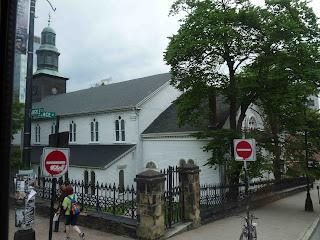Upon arriving in Halifax, our group all voted to see the Royal Nova Scotia International “Tattoo,” featuring over 2,000 world-class Canadian and international military and civilian performers. They have pipes and drums, military and civilian bands, historic reenactments, dancers, acrobats, choirs, military displays and competitions, drama and comedy in a number of innovative acts.
Why is it called Tattoo, you ask? Well, I asked too. In 17th century Dutch villages, drummers marched through the streets summoning British soldiers to return to their quarters from the taverns and inns. A drumbeat signaling innkeepers to “doe den tap toe” or “turn off the taps” was shortened to “tattoo.”
We started our first full day of touring in Halifax with a first class motor coach tour. Our guide showed up in his kilts and was informative as well as entertaining. The terrain in Nova Scotia is very different from Gaspe and Prince Edward Island. The Halifax area is very, very rocky.
We stopped at the Fairview Lawn Cemetery, the burial site for the protestant victims of the Titanic, April 15, 1912. Only 700 out of 2,200 were saved. 328 Titanic victims were recovered. 209 bodies were brought to Halifax, the closest port to the area of the sinking. Most were men, since woman and children were put on the life boats, but there are 4 women buried at Fairview. The graves are lined up outlining the bow of the ship.
One headstone marked the grave of an unknown child whose remains recovered after the disaster, but our guide informed us that just a few years ago, thru DNA, they discovered the child’s name. He was a 2 year old boy from England.
Citadel Hill has served as the site of four different forts since 1749. Each was built during a time of perceived threat. The Citadel we toured was the last to be built and took over 28 years to complete, finished in 1856.
One of our guests we call Marsha “Small” (because our wagonmaster is Marcia “Tall”) cracked me up standing next to this soldier.
During two world wars, the Citadel served as a sentinel on the home front and a symbol for those departing for overseas. In front of the fortress is a beautiful clock/bell tower.
December 6, 1917, a Belgium steamer (Imo) sliced into the French munitions freighter (Mont Blanc) in Halifax Harbour. Mont Blanc blew up and resulted into an explosion that flattened six square kilometers of the city. The blast created earth tremors and a huge wave ripped ships from their moorings, tossing them about like toys. More than 25,000 homes were destroyed or seriously damaged. Casualties were horrific – 2,000 killed and 9,000 injured. Below is a picture of personal objects recovered from bodies of two victims of the explosion.
Somehow the oldest wooden house in Nova Scotia withstood the explosion.
We toured through the section of most beautiful homes in Halifax. The “castle house” is my favorite.
Built by the Olands of Oland Brewery and the sponsor of the Bluenose II. It’s the most expensive house in Halifax, worth $5-6 million.
Then it was on to the beautiful downtown gardens.
We had lunch at Peggy’s Cove, my new favorite place.
Peggy’s Cove is a picturesque village and lighthouse and is among the most photographed places in Canada. I could spend all day in this town just taking photos. It is an absolutely gorgeous setting. But then again, I’m partial to lighthouses.
We stopped at a monumental work of art. Now what would you do with a 30 metre (.01 mile) piece of granite in your backyard? Well in 1977, Artist William deGarthe, age 70, decided to make it a piece of artwork. He chiseled figures sleeping in the rock for over 10 million years. A monument to the hard-working fishermen of his adopted home, Peggy’s Cove.
While driving home, we stopped when we saw this house completely painted with a Muriel of Peggy’s Cove to remind people of the romantic folk tale about how the Cove got its name. The artist, Ivan Frazier, grew up in this house. It was his grandmothers. As it happened, while we were stopped for pictures, he drove up and introduced himself and gave us copies of the 3 books he wrote about Peggy’s Cove. WHAT ARE THE CHANCES OF THAT HAPPENING! How lucky can we be?
We invited him on the bus to tell us the folk tale. Young Petty was travelling to Halifax to meet her fiancé when the ship she was in foundered on the rocks. She was rescued by local folk, and when visitors went to see her they would say they were going to see “Peggy of the Cove.”
As he finished, he laughed as he told us the neighbor next door, said his grandmother would be rolling over in her grave if she saw this house now. LOL You can visit his website at: http://peggyofthecove.com/
Subscribe to:
Post Comments (Atom)























No comments:
Post a Comment